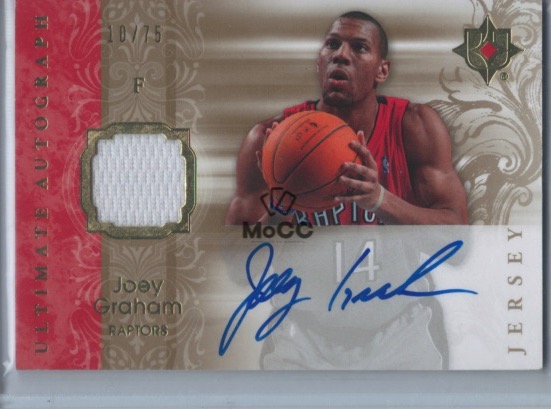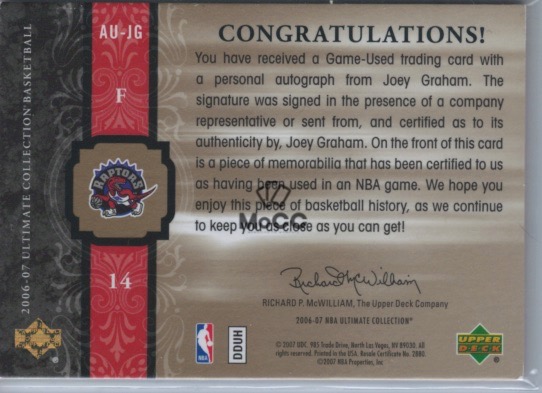On 28 June 2006, the NBA announced that it was making the first change to the basketball in over 35 years from a leather ball to a synthetic ball. The newly designed ball lasted from October to December 2007 before being changed back to leather. What happened?
On a particular Sunday morning, I took some of my card collection out to share with friends. When I got to showing Joey Graham’s autograph and jersey card, my friends pointed out something noticeably different with the card that I had not noticed before. It was not the player, nor the autograph, the jersey, or the serial number. It was the basketball that Graham was holding.
This was back in 2007. Technology was the trend, and for those who remember, 9 January 2007 was the date when the late Apple CEO Steve Jobs announced the first iPhone. On the sports front, a ball technology that would change the NBA world (for three months) was being introduced for the upcoming season.
Dubbed Cross-Traxxion technology by Spalding, synthetic basketballs were to replace the previous leather basketballs beginning in the 2007-2008 NBA season.
These newly designed balls were cheaper to produce, and were supposed to feel broken in immediately after production. The problem with leather basketballs was that it required breaking in by the NBA teams.
According to Marketplace, at the start of the NBA season, Spalding would send about 72 new leather balls to each of the NBA teams for free. Before it is sent out, Spalding would use a “bounce machine” to create the sensation of a ball being bounced against a hardwood floor. After fifty bounces, the balls are then sent on to NBA teams for further breaking in. These balls are then used by the NBA teams for practices for up to two months, before they can become game-ready balls. With this new ball, this extensive breaking in process would not be required.
Unfortunately, when the players did receive this new ball in time for 2007 NBA training camp in October, the reaction was negative. Players reported that the ball caused cuts to their fingers, it did not bounce as well, and was also slippery when wet.
The Dallas Mavericks Study
If you had keen eyes, you may have noticed that on the Joey Graham card, the ball had “Dallas Mavericks” written on the ball, suggesting that Graham was shooting a Dallas Mavericks ball at the time of the photo. What is interesting about this particular card is that out of the thirty teams in the 2007 NBA season, Joey Graham had chosen the ball from the only team that requested a scientific study against this new basketball. The negativity of the ball from the players prompted Dallas team owner Mark Cuban to request University of Texas at Austin’s physics department to undertake a scientific comparison of the leather and the synthetic ball.
According to Complex, the University of Texas at Austin’s study found that, while the cause of the reported player’s cuts could not be explained, the synthetic ball bounced 5 to 8 percent lower when dropped from 4 feet and it also bounced 30 percent more erratically than its leather counterpart. It also supported the fact that the synthetic ball was much more slippery when wet.
Could the picture taken with Graham just be a coincidence? Or was it an easter egg planted by Upper Deck in memory of the synthetic ball and its study?
Following an extensive media coverage and negativity surrounding the basketball, NBA Commissioner David Stern issued a statement on 11 December 2017 to revert back to leather balls for all NBA games at the start of January 2018.
“Our players’ response to this particular composite ball has been consistently negative and we are acting accordingly.”
– 11 December 2007, David Stern, NBA Commissioner (1984 to 2014)
Not everyone wanted the leather balls back in the NBA. The Los Angeles Times reported that the People for the Ethical Treatment of Animals (PETA) objected to the leather ball because thousands of cows were to suffer if the NBA goes back to a leather basketball and wrote:
“PETA would like to offer a lifetime supply of cruelty-free hand cream to any NBA siss … excuse me, superstar who’d be willing to give the composite ball another shot. Recreational players and NCAA athletes have been using composite balls for years without experiencing scratches or scrapes — but we understand that the delicate hands of pampered NBA superstars are far more sensitive than those of your average Joe who actually has to work for a living.”
– Dan Shannon, PETA manager of campaigns
Whether it is just a coincidence or not, the short-lived NBA synthetic ball, with its distinct look and design, will forever be remembered by this Joey Graham card and its “Dallas Mavericks” roots. The NBA has not considered changing its leather ball since then, and it does not look like there are any plans to change the leather basketball in the near future.
How did Graham do with the synthetic vs leather ball?
Before the end of this story, you may be left wondering how Joey Graham actually performed with the synthetic ball. Was this new ball as bad as some players claimed it to be? Graham’s statistics suggest it is not. Graham played 11 out of 31 games between October to the end of December 2017 and in that span, had two double-digit scoring games (13 and 12) with the new ball. On the other hand, he played a total of 23 out of 49 games for the rest of the season with the old leather ball (January to April 2018) and only had one double-digit scoring game (13). On paper, it is arguable that Graham played better with the synthetic ball – the ball rightly chosen for his card.
On a side-note, the NBA announced that it will be going to Wilson beginning the 2020-2021 NBA season, ending the long time cooperation between Spalding and the NBA.
Special thanks to Andy Lau who pointed out this card’s basketball story and friends Hyster Chan, Perrin Lai and his son Colin, and Stanley Wong.
Resources:
- C Gaine. “Remembering One of the NBA’s Biggest Failed Experiments: The “New Ball”. Sports Illustrated, 12 April 2017. https://www.si.com/nba/2015/02/18/michael-jordan-bulls-jersey-number-12
- N King. “Consider the basketball: NBA swaps out balls for a new crop.” Marketplace, 25 October 2013. https://www.marketplace.org/2013/10/25/consider-basketball-nba-swaps-out-balls-new-crop/
- M Penner “They’re all protecting some hide.” Los Angeles Times, 14 December 2006. https://www.latimes.com/archives/la-xpm-2006-dec-14-sp-briefing14-story.html
- M Stein. “Leather ball will return on Jan. 1.” ESPN, 12 December 2006. https://www.espn.com/nba/news/story?id=2694335


